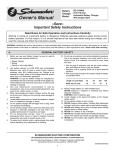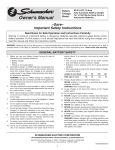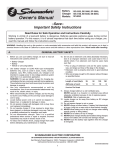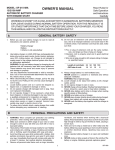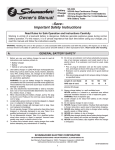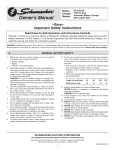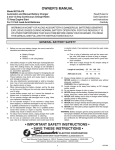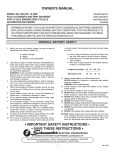Download Schumacher Electric SE-1052 Owner`s manual
Transcript
Battery Charger Models: Owner's Manual SE-1010-2, SE-1012D SE-1052, SE-1250 –Save– Important Safety Instructions Read Rules for Safe Operation and Instructions Carefully Working in vicinity of a lead-acid battery is dangerous. Batteries generate explosive gases during normal battery operation. For this reason, it is of utmost importance that each time before using your charger, you read this manual and follow the instructions exactly. WARNING: Handling the cord on this product or cords associated with accessories sold with this product, will expose you to lead, a chemical known to the State of California to cause cancer and birth defects or other reproductive harm. Wash hands after handling. A. 1. GENERAL BATTERY SAFETY electric shock. If an extension cord must be used, make sure that: Before you use your battery charger, be sure to read all instructions and cautions printed on: • Pins on plug of extension cord are the same number, size, and shape as those of plug on charger. • Extension cord is properly wired and in good electrical condition. • Wire size is large enough for AC ampere rating of charger, as specified below: _____________________________________________ Length of cord (feet): 25 50 100 150 AWG size of cord: 16 14 10 8 _____________________________________________ • Battery Charger • Battery • Vehicle or unit using battery 2. Use battery charger on LEAD ACID type rechargeable batteries only, such as used in autos, trucks, tractors, airplanes, vans, RV's, trolling, motors, etc. Charger is not intended to supply power to low-voltage electrical system other than in an automotive application. WARNING: Do not use battery charger for charging drycell batteries that are commonly used with home appliances. These batteries may burst and cause injury to persons and damage to property. 3. Use only attachments recommended or sold by manufacturer. Use of non-recommended attachments may result in fire, electric shock, or injury. 4. When disconnecting the battery charger, pull by the plug, not by the cord. Pulling on the cord may cause damage to cord or plug. 5. Locate battery power cord so it cannot be stepped on, tripped over, or subjected to damage or stress. 6. Do not operate charger with damaged cord or plug. Have cord replaced immediately. 7. Do not operate charger if it has received a sharp blow, been dropped, or otherwise damaged in any way. Take it to a qualified professional for inspection and repair. 8. Do not disassemble charger. Take it to a qualified professional when service or repair is required. Incorrect reassembly may result in electric shock or fire. 9. To reduce risk of electric shock, unplug charger from outlet before attempting any maintenance or cleaning. 10. Do not use an extension cord unless absolutely necessary. Use of an improper extension cord could result in fire or 11. Always charge battery in a well ventilated area. NEVER operate in a closed-in or restricted area without adequate ventilation. WARNING: Risk of explosive gas. 12. Locate charger as far away from battery as DC charger cables permit. 13. Do not expose charger to rain or snow. 14. NEVER charge a frozen battery. If battery fluid (electrolyte) is frozen, bring into a warm area to thaw before charging. 15. NEVER allow battery acid to drip on charger when reading specific gravity or filling battery. 16. NEVER set a battery on top of charger. 17. NEVER place charger directly above battery being charged. Gases from battery will corrode and damage charger. 18. NEVER touch the battery clips together when the charger is energized. WARNING: Battery chargers get hot during operation and must have proper ventilation. Air needs to flow around entire charger. Do not set on flammable items like carpeting, upholstery, paper, cardboard, etc. Charger will damage leather and melt plastic and rubber. SCHUMACHER ELECTRIC CORPORATION 801 BUSINESS CENTER DRIVE • MOUNT PROSPECT, ILLINOIS 60056-2179 Send Warranty Product Repairs to: 1025 E. Thompson, Hoopeston, IL 60942-0280 Call Customer Service if you have questions: 1-800-621-5485 1 00-00-000496/0103 B. 1. 2. 3. 4. 5. PERSONAL PRECAUTIONS AND SAFETY WARNING: Wear complete eye protection and clothing protection, when working with lead-acid batteries. Make sure someone is within range of your voice or close enough to come to your aid when you work with or near a lead-acid battery. Have plenty of fresh water and soap nearby for use if battery acid contacts skin, clothing, or eyes. If battery acid contacts skin or clothing, wash immediately with soap and water. Avoid touching your eyes while working with a battery. Acid particles (corrosion) may get into your eyes! If acid enters your eye, immediately flood eye with running cold water for at least 10 minutes. Get medical attention immediately. Remove all personal metal items such as rings, bracelets, C. 6. 7. 8. necklaces, and watches when working with a lead-acid battery. A lead-acid battery can produce a short-circuit current high enough to weld a ring (or the like) to metal, causing a severe burn. Take care not to drop a metal tool or other metal onto the battery. Metal may cause sparking or short circuit the battery or another electrical device. Sparking may cause an explosion. Always operate battery charger in an open well ventilated area. NEVER smoke or allow a spark or flame in the vicinity of the battery or engine. Batteries generate explosive gases! GROUND AND AC POWER CORD CONNECTIONS Charger should be grounded to reduce the risk of electric shock. Charger is equipped with an electric cord having an equipment grounding conductor and a grounding plug. The plug must be plugged into an outlet that is properly installed and grounded in accordance with all local codes and ordinances. This battery charger is designed for use on a nominal 120 volt circuit and has a grounded plug that looks like the plug illustrated in FIGURE 1 (A). This plug should be used in a grounded outlet. The plug pins must fit the receptacle (outlet). ADAPTER: A temporary adapter, as shown in FIGURE 1 (B) and (C), may be used to connect the charger plug to a two pole receptacle (outlet), as shown in FIGURE 1 (B). GROUNDING SCREW NOTE: The temporary adapter should be used only until a properly grounded outlet can be installed by a qualified electrician. FIGURE 1 GROUNDING METHODS DANGER: Never alter the AC cord or plug provided. If it will not fit outlet, have a proper outlet installed by a qualified electrician. Improper connection can result in a risk of an electrical shock. DANGER: Before using an adapter, as illustrated, be certain that the center screw of the outlet plate is grounded. The green-colored rigid ear or lug extending from the adapter must be connected to a properly grounded outlet. Make certain it is grounded. If necessary, replace original outlet cover plate screw with a longer screw that will secure adapter ear or lug to outlet cover plate and make ground connection to grounded outlet. USE OF ADAPTER PLUG NOT ALLOWED IN CANADA D. PREPARING TO CHARGE 1. Make sure that the voltage of the battery and the charger match. Select battery charger switch, if this model has one, accordingly. 2. Clean battery terminals. Take care to keep corrosion from coming in contact with your eyes. 3. If required, add distilled water in each cell until battery acid reaches levels specified by battery manufacturer. This helps purge excessive gas from cells. Do not overfill. For a battery without cell caps, carefully follow manufacturer’s recharging instructions. 4. Study all battery manufacturer’s specific precautions, such as removing or not removing cell caps while charging, and recommended rates of charge. 5. Be sure area around battery is well ventilated while battery is being charged. Gas can be forcefully blown away by using a piece of cardboard or other non-metallic material as a fan. 6. If necessary to remove battery from vehicle to charge, always remove grounded terminal from battery first. Make sure all accessories in the vehicle are off, so as not to cause an arc. 7. A marine (boat) battery must be removed and charged on shore. To charge it on board requires equipment specially designed for marine use. Charger Selection Guide (see section H) 2 Recommended Battery Uses Ampere Rating Charging Hours 2 amp 3-6 Hrs. Charge motorcycle, snowmobile, lawnmower, trickle charge car, truck, RV, marine. 6 amp 6-8 Hrs. 10 amp 3-5 Hrs. Charges car, truck, RV, trolling outboard, tractor farm equipment. 30 amp Boost 2 minutes on 5 minutes off 50 amp Engine Start 5 seconds on 240 seconds off Boost battery for 2 minutes before Cranking Engine. Cranking assists helps turn engine when battery power is low. E. OPERATING INSTRUCTION: CHARGING BATTERY IN VEHICLE When charging battery in the vehicle, take care to determine the battery type and which post i s grounded. To reduce risk of a spark near battery, follow these steps when battery is installed in vehicle. WARNING: A spark near battery may cause battery explosion. 1. Position AC power cord and DC charging cords to reduce risk of damage by hood, door, or moving engine parts. 2. Stay clear of fan blades, belts, pulleys, and other parts that can cause injury. 3. Check polarity of battery posts. Battery case will be marked by each post: POSITIVE (POS, P, +) and NEGATIVE (NEG, N, -). NOTE: The positive battery post usually has a larger diameter than the negative post. 4. Determine which post of battery is ground (connected) to chassis. NOTE: The negative post is normally grounded. WARNING: Do not connect clip to carburetor, fuel lines, or sheetmetal body parts. NOTE: Attach clips to battery post and twist or rock back and forth several times to make a good connection. This tends to keep clips from slipping off terminals and helps to reduce risk of sparking. 6. Select amperage. 7. Follow steps 1-4 in Battery Charger Section K. 8. When the battery is fully charged, unplug the charger from the AC power source. 9. Remove charger clips from (1 ) chassis and (2) battery pole in that order. 10. Clean and store battery charger. Negative GROUNDED POST 5A. For negative-grounded vehicle, connect POSITIVE (RED) clip from battery charger to POSITIVE (POS, P, +) ungrounded post of battery. Connect NEGATIVE (BLACK) clip to vehicle chassis or engine block away from battery. Connect to a heavy gauge metal part of the frame or engine block. Positive GROUNDED POST 5B. For positive-grounded vehicle, connect NEGATIVE (BLACK) clip from battery charger to NEGATIVE (NEG, N, -) ungrounded post of battery. Connect POSITIVE (RED) clip to vehicle chassis or engine block away from battery. Connect to a heavy gauge unpainted metal part of the frame or engine block. F. OPERATING INSTRUCTION: CHARGING BATTERY OUT OF VEHICLE When charging battery out of vehicle, take care to determine the battery type. To reduce risk of a spark near battery, follow these step when battery is outside vehicle. WARNING: A spark near the battery may cause battery explosion. WARNING: When removing battery from vehicle or boat, disconnect grounded pole first. When disconnecting, make sure all accessories are off, so as not to cause an arc. (NOTE: A marine (boat) battery must be removed and charged on shore. (To charge on board requires special equipment designed for marine use.) WARNING: When reinstalling battery, attach the ground post first. 1. 2. 3. 4. 5. 6. 7. Check polarity of battery posts. Battery case will be marked by each post: POSITIVE (POS, P, +) and NEGATIVE (NEG, N, -). NOTE: The positive battery post usually has a larger diameter than the negative post. Attach a 24-inch long (or longer) 6-gauge (AWG) insulated battery cable to NEGATIVE (NEG, N, -) battery post. (The 24" lead is not supplied. You may purchase at most automotive stores.) The 24" lead provides a safer connection condition. Sparking or arcing could occur when connecting the charger clip to the lead. Connect POSITIVE (RED) charger clip to POSITIVE (POS, P, +) post of BATTERY. Rock clip back and forth to make good connection. Position yourself and free end of 24 inch cable as far away from battery as possible. Then connect NEGATIVE (BLACK) charger clip to free end of cable. WARNING: Do not face battery when making final connection. Rock clip back and forth to make a good connection. Select amperage: Follow steps 1-4 in Battery Charger Section. When battery is fully charged, unplug charger from AC power source. POSITIVE NEGATIVE BATTERY CHARGER BATTERY 24" OF 6 Gauge Cable POWER CORD TO GROUNDED POWER OUTLET 8. 9. When battery is fully charged and the charger is unplugged: (1) Remove clip from end of the Negative end of cable, then (2) Remove clip from Positive battery post, in that order. Clean and store battery charger. WARNING: Be sure area around the battery is well ventilated while battery is being charged. Gas can be forcefully blown away by using a piece of cardboard or other nonmetallic material as a fan. 3 G. METER FUNCTIONS PERCENT OF CHARGE The percent of charge scale is intended as a visual aid to help simplify detemmining the state of charge. It is scaled for use with the 6 or 10 amp charge rates only. For the 2 amp charge rate, use the red triangle.The percent of charge is based on current draw by the battery. For this reason accuracy will vary with the size and battery type. Typically a 28 ampere hour battery will draw less current at end charge than a 140 ampere hour wet cell battery. This means that the indication for a fully charged large battery may be slightly less than 100%. 2 amp DC AMPS 2 AMP RATE CHARGE % 100 0 2 4 6 75 8 50 10 25 12 For the 2 amp charge rate a red triangle has been provided within the green area of the meter scale. It’s accuracy has been calibrated for use with small battery. As a battery takes on a charge, correspondingly less of the red area will fall under the meter needle. The Ammeter The ammeter indicates the amp draw on the charger when a fully discharged battery is connected to the charger. The meter will read the maximum output rating of the charger 2 amps, 10 amps, or 30 amps depending on the charger and switch position you have chosen. The charge on the 2 amp or the 10 amp, will gradually taper down as the battery nears full charge. As the charge current tapers, the ammeter needle will also move down. The 2 amp charge produces such a small current that it will not show up very well on the meter. 10 amp DC AMPS 2 AMP RATE CHARGE % 0 2 4 100 6 The 50 amp boost charge (on the SE-1250 only) may be used for a quick charge prior to using the engine start feature. The meter will indicate around the 30 amps line if the battery is fully discharged and less if the battery is partially charged. Follow duty cycle instructions for this boost position. See Meter Views The charger meter needle will indicate somewhere between the solid line and the dotted line when the charging is first started. The variation is due to the difference in battery conditions and construction of the battery. A battery that is not fully charged will not require the charger to begin the charge at the highest rating, such as the 10 amp on the 10 amp charge position. The battery is charged when the meter indicates near the dotted line shown in the view at the right. This is about 1/2 of the selected charge rate. (about 4-5 amps on the 10 amp setting). 4 75 8 50 10 25 12 50 amp Engine Start DC AMPS CHARGING 0 5 10 15 20 START 25 30 H. BATTERY CHARGER CONTROLS SWITCHES The SE-1012D has one charge rate only . The switch on this unit is for selecting the charging voltage, either 6 volt or 12 volt. Match the charging voltage to the battery being charged. The SE-1052, SE-1010-2 and the SE-1250 models are 12 volt only and must not be used on 6 volt batteries. The switches on these chargers are for selecting the charging rates (amps) desired for your application. Use the 2 amp rate feature offered on some models to charge smaller batteries such as those on motorcycles, snowmobiles, etc. Use the 10 amp rate to charge larger automotive batteries. On the SE-1250, the 30 amp boost and the 50 amp start position is in the same location. Make sure you follow the duty cycle shown on the front of the charger when using these positions. To obtain the 50 amps start simply turn the ignition key on the vehicle. Models SE-1052 and SE-1250 have Engine Start. TIMER The 12 hour timer on SE-1012D is useful for preventing overcharging of the battery. Set the pointer knob to the number of hours you want the charger to be on. The knob will automatically rotate counter clockwise indicating the remaining charge time. When the knob reaches the OFF position, the charger will shut off. When the HOLD position is selected, the charger will remain on indefinitely. Familiarize yourself with the action of these settings by rotating the knob through each position several times. CIRCUIT BREAKER I. This battery charger is equipped with a self-resetting circuit breaker. This device protects the charger from temporary overloads. In the event of an overload, the circuit breaker will trip open and after a short cooling off period will reset automatically. This process is known as cycling and can be recognized by an audible clicking sound. J. NOTE: Clicking sound is normal. Wait until charger automatically resets itself. CAUTION: Persistent clicking (more than 30 minutes) may indicate reverse connection or shorted battery cells. BATTERY TYPES Three basic types of lead-acid batteries can be given a charge with this charger: (1 ) Conventional and Low Maintenance, (2) Maintenance Free, (3) Deep Cycle. Conventional and Low Maintenance Batteries. These are the antimony/lead batteries. Conventional/Low Maintenance batteries require periodic addition of water to the acid solution (electrolyte). Additional water may be added by removing the filler caps located on the top of the battery. IMPORTANT: When antimony is known to be one of the materials used in the battery's construction, that battery is a Low Maintenance/Conventional type. CAUTION: Some Low Maintenance batteries have a relatively smooth top without any apparent battery filler caps. If, however, the battery manufacturer/distributor recommends periodic checking of electrolyte level and provides access to the battery for water additions, the battery is probably a Low Maintenance/ Conventional type. Maintenance Free Batteries. These are calcium/lead batteries and normally do not require water additions. Therefore, filler caps have been removed from the battery surface. These batteries will have a smooth or sealed appearance. Deep Cycle Batteries. These heavy duty batteries are used in boats, construction equipment, sump pumps, etc. They are normally marked DEEP CYCLE on the outside of the case. 5 K. BATTERY CHARGING 1. Before charging any battery, make sure the electrolyte (battery fluid) in each cell is at correct level. This is not required on maintenance free batteries. Read instructions on battery. 2. Set switches and or timers to Off, if the position is available. If no Off position is on your charger, set in the lowest charge rate featured usually, 2 amp. 3. If the battery is being charged inside the vehicle, use connection procedures outlined in Section E. Should the battery be removed from the vehicle, follow the instructions in Section D (step 6) and Section F. Plug the power cord into the AC outlet. 4. Set the power switch from Off (or the lowest charge rate) to the desired charge position. NOTE: This charger is a MANUAL type charger and the charging must be monitored closely to prevent overcharging of the battery. L. CHARGE PERIOD The approximate time required to bring a battery to a full charge state depends upon the number of ampere hours (AH’s! depleted from the battery. AH’s are determined by multiplying the number of hours time the number of amps supplied by the battery to the load For example- If a load was connected to battery which drew 7 amperes for a period of five hours, the battery will have supplied 35 AH. The approximate recharge time would be calculated by dividing 35 AH depleted from the battery, by the ampere charge rate of the charger .To allow for tapering of the charge rate add 25% to the charge time. M. INDICATIONS OF A FULLY CHARGED BATTERY A hydrometer reading of the specific gravity of the electrolyte (fluid) of a battery in good condition should be between 1.25 and 1.285. When a battery reaches 80-85% of full charge, bubbles will appear on the surface of the fluid As the battery nears full charge, bubbling will become more vigorous. When the meter reaches about half the charge rate, see Meter Function, Section G. N. ENGINE START 1. Connect the charger to the battery following instructions given in Section K. 2. Set charger to Off position, (on SE-1052 set at the 2 amp position). 3. Plug power cord into AC outlet, then move switch from Off to Engine Start. On SE-1052 move from 2 amp to Engine Start. 4. During extremely cold weather, or if the battery is fairly exhausted, charge the battery for a few minutes before you attempt the Engine Start. 5. Crank the engine by turning the ignition key. 6. If the engine fails to start, let the battery charge for another/few minutes then, try the engine start again. O. CHARGER LOCATION PRECAUTIONS Never place the charger directly above battery being charged, gases from battery could damage the charger. Never allow the battery acid to drip on charger when reading specific gravity or filling battery. Do Not operate the charger in a closed in area or restrict ventilation in any way. Keep off from carpets, seats, etc. Do Not set the battery on top of the charger. LIMITED WARRANTY than this limited warranty and expressly excludes any implied warranty including any warranty for consequential damages. SCHUMACHER ELECTRIC CORPORATION, 801 BUSINESS CENTER DRIVE , MT. PROSPECT, IL 60056-2179, MAKES THIS LIMITED WARRANTY TO THE ORIGINAL PURCHASER AT RETAIL OF THIS PRODUCT. THIS LIMITED WARRANTY IS NOT TRANSFERABLE. This is the only express limited warranty and the manufacturer neither assumes nor authorizes anyone to assume or make any other obligation towards the product other than this express limited warranty. The manufacturer makes no warranty of merchantability or fitness for purpose of this product and expressly excludes such from this limited warranty. Some states do not allow the exclusion or limitation of incidental or consequential damages or length of implied warranty so the above limitations or exclusions may not apply to you. “This warranty gives you specific legal rights, and you may have other rights which vary from state to state.” Schumacher Electric Corporation warrants this battery charger for 2 years from date of purchse at retail against defective material or workmanship. If such should occur, the unit will be repaired or replaced at the option of the manufacturer. It is the obligation of the purchaser to forward the unit together with proof of purchase, transportation and / or mailing charges prepaid to the manufacturer or its authorized representative. This limited warranty is void if the product is misused, subjected to careless handling, or repaired by anyone other than the factory or other authorized factory representative. The manufacturer makes no warranty other 6 MANUAL DEL PROPIETARIO EL TRABAJAR CERCA DE BATERIAS DE PLOMO-ACIDO ES PELIGROSO. LAS BATERIAS GENERAN GASES EXPLOSIVOS DURANTE LA OPERACION NORMAL DE LA BATERIA. POR ESTA RAZON ES SUMAMENTE IMPORTANTE QUE LEA ESTE MANUAL Y OBSERVE EXACTAMENTE LAS INSTRUCCIONES CADA VEZ QUE SE USE EL CARGADOR. A. SEGURIDAD GENERAL DE LA BATERIA 1. Antes de usar su cargador de batería, asegúrese de leer todas las instrucciones y los avisos de precauciones impresos en: * El cargador de batería * La batería * El vehículo o la unidad que usa la batería 2. Use el cargador de batería sólo en baterías recargables de tipo PLOMO-ACIDO, tales como aquellas usadas en trocas, carros, tractores, aviones, motores de troles, camionetas, RV, etc. El cargador no está diseñado para suministrar energía a un sistema eléctrico de bajo voltaje diferente a una aplicación automotriz. ADVERTENCIA: No use el cargador de batería para cargar baterías de célula seca que se usan comúnmente con artefactos domésticos. Estas baterías pueden reventar y causar lesiones a las personas y daños a la propiedad. 3. Use sólo los aditamentos recomendados o vendidos por el fabricante. El uso de aditamentos no recomendados puede resultar en un incendio, choque eléctrico o lesiones. 4. Al desconectar el cargador de batería, tire del enchufe y no del cordón. El tirar del cordón puede causar daño al cordón o al enchufe. 5. Coloque el cordón de potencia de la batería de manera que no pueda pisarse, tropezarse con el mismo, o que esté expuesto a daño o esfuerzo. 6. No opere el cargador con un cordón o enchufe dañado. Haga que el cordón sea reemplazado inmediatamente. 7. No opere el cargador si ha recibido un golpe fuerte, se ha caído o se ha dañado de alguna manera. Llévelo a un profesional calificado para inspeccionar y reparar. 8. No desarme el cargador. Llévelo a un profesional calificado cuando se requiera servicio o reparación. Un rearmado incorrecto puede resultar en un choque eléctrico o en un incendio. 9. Desenchufe el cargador del tomacorriente antes de tratar de mantener o limpiar, para reducir el riesgo de choque eléctrico. 10. No use un cordón de extensión a menos que sea absolutamente necesario. El uso de un cable de extensión incorrecto podría resultar en incendio o choque eléctrico. Si debe usarse un cable de extensión, asegúrese que: * Las clavijas del enchufe del cable de extensión sean iguales en cantidad, tamaño y forma a aquéllas del enchufe en el cargador. * El cable de extensión esté apropiadamente cableado y en buen estado eléctrico. * El tamaño del conductor sea suficientemente grande como para la clasificación de amperios de CA del cargador, según se especifica abajo: tierra. La oreja o aleta rígida de color verde que se extiende desde el adaptador debe estar conectado a un tomacorriente apropiadamente conectado a tierra. Asegúrese que está conectado a tierra. Si fuera necesario reemplace el tornillo original de la placa de cubierta del tomacorriente con un tornillo más largo que asegurará la oreja o aleta del adaptador a la placa de cubierta del tomacorriente y efectuará la conexión a tierra del tomacorriente conectado a tierra. D. PREPARANDO LA CARGA 1. Asegúrese que tenga una batería de 12 voltios o de 6 voltios de plomo-ácido y seleccione correspondientemente el interruptor del cargador de la batería. 2. Limpie los terminales de la batería. Tenga cuidado para evitar que la corrosión entre en contacto con sus ojos. 3. Si fuera requerido, agregue agua destilada a cada célula hasta que el ácido de la batería alcance los niveles especificados por el fabricante de la batería. Esto ayuda a purgar el gas excesivo de las células. No llene en exceso. Siga cuidadosamente las instrucciones de recarga del fabricante para una batería sin tapas individuales de las células. 4. Estudie todas las precauciones específicas del fabricante de la batería, tales como sacar o no sacar las tapas de las células al cargar y velocidades recomendadas de carga. 5. Asegúrese que el área alrededor de la batería esté bien ventilada mientras se carga la batería. El gas puede soplarse alejado usando una pieza de cartón u otro material no metálico como un abanico. 6. Saque siempre el terminal conectado a tierra primero, si fuera necesario sacar la batería del vehículo para cargar. Asegúrese que todos los accesorios en el vehículo estén desconectados de manera que no puedan originar un arco eléctrico. 7. Una batería marina (de barco) puede sacarse y cargarse en tierra. La carga a bordo requiere equipo especialmente diseñado para uso marino. E. INSTRUCCIONES DE OPERACION: CARGA DE LA BATERIA EN EL VEHICULO Al cargar la batería en el vehículo tenga cuidado en determinar el tipo de batería y cuál de los postes está conectado a tierra. Siga los pasos siguientes cuando la batería está instalada en un vehículo para reducir el riesgo de una chispa cerca de la batería. ADVERTENCIA: Una chispa cerca de la batería puede causar la explosión de la batería. 1. Coloque en posición el cordón de potencia de CA y los cordones de carga de CC para reducir el riesgo de daño por parte del capó, puerta o piezas móviles del motor. 2. Manténgase alejado de aletas de ventilador, correas, poleas y otras piezas que puedan causar lesiones. 3. Inspeccione la polaridad de los postes de la batería: POSITIVA (POS, P, +) y NEGATIVA (NEG, N, -). NOTA : El poste positivo de la batería generalmente tiene un diámetro mayor que el poste negativo. 4. Determine cuál poste de la batería está conectado al chasis. NOTA: El poste negativo está generalmente conectado a tierra. POSTE NEGATIVO CONECTADO A TIERRA 5A. Para un vehículo conectado a tierra por el negativo, conecte la pinza de conexión POSITIVA (ROJA) del cargador de batería al poste POSITIVO (POS, P, +) no conectado a tierra de la batería. Conecte la pinza de conexión NEGATIVA (NEGRA) al chasis del vehículo o al bloque del motor alejado de la batería. Conecte a una pieza de metal de grueso calibre de la carrocería o del bloque del motor. POSTE POSITIVO CONECTADO A TIERRA 5B. Para un vehículo conectado a tierra por el positivo, conecte la pinza de conexión NEGATIVA (NEGRA) del cargador de la batería al poste NEGATIVO (NEG, N, -) no conectado a tierra. Conecte la pinza de conexión POSITIVA (ROJA) al chasis del vehículo o al bloque del motor alejado de la batería. Conecte a una pieza de metal sin pintar de grueso calibre de la carrocería o del bloque del motor. ADVERTENCIA: No conecte las pinzas de conexión al carburador, tuberías de combustible ni piezas de la carrocería de lámina metálica. NOTA: Fije las pinzas de conexión al poste de la batería y gire o haga oscilar varias veces para efectuar una buena conexión. Esto tiende a evitar que las pinzas de conexión se deslicen de los terminales y ayuda a reducir el riesgo de producción de chispas. 6. Conecte el cordón de potencia de CA y a continuación efectúe los cambios deseados de posición. (Vea Carga de Batería - sección H). 7. Observe el medidor por una respuesta apropiada, y si algo no parece correcto refiérase a la sección de localización de fallas de este manual. 8. Desenchufe el cargador del tomacorriente de CA cuando la batería está completamente cargada. 9. Cuando la batería está cargada y el cargador está desenchufado: (1) Saque la pinza de conexión del chasis del vehículo, y a continuacion; (2) Saque la pinza de conexión del poste de la batería, en ese orden. 10. Limpie y almacene el cargador de la batería. F. INSTRUCCIONES DE OPERACION: CARGA DE LA BATERIA FUERA DEL VEHICULO Tenga cuidado en determinar el tipo de batería al cargarla fuera del vehículo. Para reducir el riesgo de una chispa cerca de la batería, siga estos pasos cuando la batería está fuera del vehículo. ADVERTENCIA: Al sacar la batería del vehículo o del barco, desconecte primero el polo conectado a tierra. Al desconectar, asegúrese que todos los accesorios estén desconectados de manera que no puedan causar un arco eléctrico. (NOTA: Una batería marina (de barco) debe sacarse y cargarse en tierra. (La carga a bordo requiere equipo especial diseñado para uso marino.) ADVERTENCIA: Fije el poste conectado a tierra primero al instalar nuevamente la batería. 1. Inspeccione la polaridad de los postes de la batería. La caja de la batería estará marcada por cada poste: POSITIVA (POS, P, +) y NEGATIVA (NEG, N, -). NOTA: El poste positivo de la batería generalmente tiene un diámetro mayor que el poste negativo. 2. Fije un cable aislado de batería de 24 pulgadas de largo (o mayor) de calibre 6 (AWG) al poste NEGATIVO (NEG, N, -) de la batería. (No se provee el cable de 24". Usted puede comprarlo en la mayoría de las tiendas de repuestos automotores.) 3. Conecte la pinza de conexión POSITIVA (ROJA) del cargador al poste POSITIVO (POS, P, +) del cargador. Haga oscilar la pinza de conexión para efectuar una buena conexión. 4. Colóquese en posición y lleve el extremo libre del cable de 24 pulgadas tan alejado de la batería como sea posible. A continuación conecte la pinza de conexión NEGATIVA (NEGRA) del conector al extremo libre del cable. ADVERTENCIA: Al efectuar la conexión final no enfrente la batería. Oscile la pinza de conexión para efectuar una buena conexión. 5. Conecte el cordón de CA y a continuación efectúe las graduaciones deseadas del cargador. (Vea Carga de Batería - sección H). 6. Observe el medidor por una respuesta apropiada, y si algo no parece correcto refiérase a la sección de localización de fallas de este manual. 7. Desenchufe el cargador del tomacorriente de CA cuando la batería está completamente cargada. 8. Cuando la batería está cargada y el cargador está desenchufado: (1) Saque la pinza de conexión del extremo del extremo Negativo del cable, y a continuación (2) Saque la pinza de conexión del poste Positivo de la batería, en ese orden. 9. Limpie y almacene el cargador de la batería. ADVERTENCIA: Asegúrese que el área alrededor de la batería esté bien ventilada mientras se carga la batería. El gas puede soplarse alejado usando una pieza de cartón u otro material no metálico como un abanico. G. FUNCIONES DEL MEDIDOR PORCENTAJE DE LA CARGA La escala de graduación del porcentaje de carga tiene por objetivo servir como un dispositivo visual para ayudar a determinar el estado de la carga. La escala de graduación está hecha para ser usada Longitud del cable (pies): 25 50 100 150 Tamaño AWG del cable: 16 12 10 8 (Calibre Americano de Conductor) 11. Cambie siempre la batería en un área bien ventilada. A causa del riesgo de gases explosivos, NUNCA opere en un área cerrada o restringida sin ventilación adecuada. 12. Coloque el cargador tan alejado como sea posible de la batería, a la máxima distancia permitida por los cables del cargador de CC. 13. No exponga el cargador a la lluvia ni a la nieve. 14. NUNCA cargue una batería congelada. Llévela a un área cálida para descongelarla antes de cargar, si el fluido (electrolito) de la batería está congelado. 15. NUNCA permita que el ácido de la batería gotee sobre un cargador al leer la gravedad específica o al llenar la batería. 16. NUNCA coloque el cargador directamente sobre la batería a cargar. Los gases de la batería desgastarán y dañarán el cargador. 17. Al activar el cargador, NUNCA toque al mismo tiempo las pinzas de conexión. 18. NUNCA junte las pinzas de los cables (una con otra) cuando esté engergizado el cardador. B. PRECAUCIONES Y SEGURIDAD PERSONALES 1. ADVERTENCIA: Al trabajar con baterías de plomo-ácido, use protección completa de los ojos y protección de la ropa. 2. Cuando usted trabaje con o esté cerca de una batería de plomo-ácido, asegúrese que alguien esté al alcance de su voz o suficientemente cerca como para ayudarlo. 3. Tenga a mano agua y jabón para usar si el ácido de la batería entra en contacto con la piel, la ropa o los ojos. Lave inmediatamente con jabón y agua si el ácido de la batería entra en contacto la piel o la ropa. 4. Al trabajar con una batería, evite tocar sus ojos. ¡Las partículas ácidas (corrosión) pueden entrar en sus ojos! Lave inmediatamente el ojo con agua corriente fría durante un mínimo de 10 minutos si el ácido penetra en el mismo. Busque atención médica inmediata. 5. Al trabajar con una batería de plomo-ácido, quítese todos los artículos personales de metal tales como anillos, brazaletes, collares y relojes. Una batería de plomo-ácido puede producir una corriente de cortocircuito suficientemente intensa como para soldar un anillo (u objetos similares) al metal, causando una quemadura grave. 6. Tenga cuidado en no dejar caer una herramienta de metal u otro metal sobre la batería. El metal puede causar chispas o colocar en cortocircuito la batería u otro artefacto eléctrico. Las chispas pueden causar una explosión. 7. Opere siempre el cargador de batería en un área abierta y bien ventilada. 8. NUNCA fume ni permita chispas o llamas en la vecindad de la batería o del motor. ¡Las baterías generan gases explosivos! 9. ADVERTENCIA - El manejo del cordón en este producto, o de los cordones asociados con los accesorios vendidos con este producto, le expone a usted al plomo, un producto químico conocido en el Estado de California de causar cáncer y defectos de nacimiento u otros daños reproductivos. Lávese las manos después de manejar estos cordones. C. CONEXIONES A TIERRA Y DEL CORDON DE POTENCIA DE CA El cargador debería conectarse a tierra para reducir el riesgo de choque eléctrico. El cargador está equipado con un cordón eléctrico que tiene un conductor de conexión a tierra del equipo y un enchufe de conexión a tierra. El enchufe debe enchufarse a un tomacorriente que esté apropiadamente instalado y conectado a tierra de acuerdo con todos los códigos y ordenanzas locales. Este cargador de batería está diseñado para usar con un circuito de 120 voltios nominales y tiene un enchufe conectado a tierra que parece como el enchufe ilustrado en la FIGURA 1(A). Este enchufe debería usarse en un tomacorriente conectado a tierra. Las clavijas del receptáculo deben calzar en el receptáculo (tomacorriente). ADAPTADOR: Puede usarse un adaptador temporario, según se muestra en las Figuras 1(B) y (C), para conectar el enchufe de conexión a tierra a un receptáculo de dos polos, según se muestra en la FIGURA 1 (B). NOTA: El adaptador temporario debería usarse solamente hasta que un electricista calificado pueda instalar un tomacorriente apropiadamente conectado a tierra. PELIGRO: Nunca altere el cordón de CA ni el enchufe provistos. Haga que un tomacorriente apropiado sea instalado por un electricista calificado si el enchufe no calza en el tomacorriente. Una conexión incorrecta puede resultar en un riesgo de choque eléctrico. PELIGRO: Antes de usar un adaptador, como ilustrado, asegúrese que el tornillo del centro de la placa del tomacorriente esté conectado a 7 solamente con un régimen de carga de 6 ó 10 amperios. Para el régimen de carga de 2 amperios, use el triángulo rojo. El porcentaje de carga está basado en la extracción actual de la batería. Por esta razón, la exactitud variará dependiendo del tamaño y el tipo de batería. Normalmente una batería de 28 amperio-hora extraerá menos corriente en la carga final que una batería de 140 amperio-hora de pila hidroeléctrica. Esto quiere decir que la indicación de carga completa de una batería grande podría ser un poco menos que el 100%. Para el régimen de carga de 2 amperios se dibujó un triángulo rojo dentro del área verde de la escala de graduación del medidor. Su precisión ha sido calibrada para usarla con una batería pequeña. A medida que se carga la batería, aparecerá cada vez menos el área roja, según corresponda, por debajo de la aguja del medidor. El Amperímetro: El amperímetro indica la extracción de amperios del cargador cuando una batería totalmente descargada se conecta a dicho cargador. El medidor leerá el régimen de descarga máxima de los 2 amperios, 10 amperios, ó 30 amperios del cargador, dependiendo de cuál sea, y la posición del interruptor que usted haya escogido. La carga en el de 2 amperios ó de 10 amperios gradualmente disminuirá a medida que la batería se vaya acercando a su carga completa. A medida que la corriente disminuya, la aguja del amperímetro también se moverá hacia abajo. La carga de 2 amperios produce tan poca corriente que casi no se podrá apreciar en el medidor. La carga de refuerzo de 30 amperios (solamente en el SE 1250) podría ser usada a manera de carga rápida antes de usar el dispositivo de arranque del motor. El medidor indicará cerca dela línea de 30 amperios, si la batería está totalmente descargada y por debajo de ese punto si la batería está parcialmente cargada. Siga las instrucciones del ciclo de trabajo para esta posición de refuerzo. Ver el Visor del Medidor: La aguja del cargador en el medidor se encontrará en algún punto entre la línea sólida y la línea punteada cuando ha comenzado a cargar. La variación es debida a la condición de la batería y a la construcción de la misma. Una batería que no está totalmente cargada no requerirá que el cargador comience a cargar en el régimen más alto, tal como el de 10 amperios en la posición de carga de 10 amperios. La batería está cargada cuando el medidor está indicando cerca de la línea punteada mostrada en el visor de la derecha. Esto será aproximadamente 1/2 del régimen de carga seleccionado. (aproximadamente 4-5 amperios en la posición de 10 amperios). H. CONTROLES PARA EL CARGADOR DE BATERÍA INTERRUPTORES Modelo SE 1012D tienen solamente un régimen de carga. El interruptor de esas unidades sirve para seleccionar el voltaje de carga, ya sea para 6 voltios o para 12 voltios. Asegúrese que el voltaje de carga y la batería que está siendo cargada sean iguales. Los modelos SE 1052, SE 1010-2 y el SE 1250 son modelos diseñados para 12 voltios solamente y no deben ser usados en baterías de 6 voltios. Los interruptores de esos cargadores sirven para seleccionar el régimen de carga (amperios) deseado para su aplicación específica. Use la posición de régimen de 2 amperios, que viene incluida en algunos modelos, para cargar baterías pequeñas tales como la de motocicleta, motonieve, etc. Use la posición de régimen de 10 amperios para cargar baterías grandes de automóviles. El Control de Tiempo (TIMER) debería estar en la posición de Retención (HOLD) cuando se esté usando el régimen de Mantenimiento de 0.300 amperios. En el SE 1250 la posición de refuerzo (BOOST) de 30 amperios y la de Encendido (Start) de 50 están en el mismo lugar. Asegúrese de seguir el ciclo de trabajo mostrado al frente del cargador cuando use estas posiciones. Para obtener el encendido de 50 amperios, simplemente dé vuelta a la llave para encender el vehículo. NO use ningún otro cargador ni posición de carga cuando encienda el motor. Los modelos SE 1052 y SE 1250 tienen el Encendido del Motor (Engine Start). CONTROL DE TIEMPO (TIMER) El Control de tiempo de 12 horas, que viene incluido en modelo SE 1012D, se utiliza para evitar una sobrecarga de la batería. Coloque el botón regulador en el número de horas que usted desee cargarla. El botón regulador automáticamente rotará en el sentido contrario a las manecillas del reloj indicando el tiempo de carga que hace falta. Cuando el botón regulador llegue la posición de apagado (OFF), el cargador se apagará. Cuando se seleccione la posición de Retención (HOLD), el cargador se mantendrá encendido indefinidamente. Familiarícese con el Control programándolo varias veces, probando el botón de regulación en cada posición varias veces. I. INTERRUPTOR DE CIRCUITO Este cargador de batería esta equipado con un interruptor de circuito para auto-restablecimiento. Este dispositivo protege al cargador de cualquier sobrecarga temporal. En el caso que ocurra una sobrecarga, el interruptor de circuito se desenganchará y después de un corto período de enfriamiento, se reenganchará automáticamente. Este proceso es conocido como el «reenganche», y podrá saber que está ocurriendo cuando escuche un «click» o sonido seco. NOTA: El sonido seco es normal. Espere hasta que el cargador se reenganche por sí sólo automáticamente. PRECAUCIÓN: Si persiste el sonido seco (por más de 30 minutos) podría indicar que hay una conexión invertida o que una celda de la batería hizo cortocircuito. J. TIPOS DE BATERÍA Se pueden cargar tres tipos de baterías de ácido de plomo con este cargador: (1) Convencionales y de Poco Mantenimiento. (2) Que No Requieren Mantenimiento. (3) De Ciclo Profundo. Baterías convencionales y de poco mantenimiento. Estas baterías son las baterías de plomo/ antimonio. Las baterías convencionales/de poco mantenimiento necesitan que se agregue agua periódicamente a la solución ácida (electrólito). Para rellenar de agua se deben quitar los tapones que están localizados en la parte superior de la batería. IMPORTANTE: Cuando se sabe que se usó antimonio como uno de los materiales para fabricar la batería, la batería es del tipo convencional/de poco mantenimiento. PRECAUCIÓN: Algunas baterías de poco mantenimiento tienen unasuperficie relativamente plana y es difícil identificar los tapones para el relleno. Sin embargo, si los fabricantes o distribuidores recomiendan que se efectúe una revisión periódica del nivel de electrólito y proporcionan acceso a la batería para agregarle agua, la batería es probablemente del tipo convencional/de poco mantenimiento. Baterías que no requieren mantenimiento. Estas son las baterías de plomo/calcio y normalmente no necesitan ser rellenadas de agua. Por lo tanto, los tapones de relleno de agua han sido eliminados de la superficie de la batería. Estas baterías tendrán una apariencia lisa o sellada. Baterías de ciclo profundo. Esta baterías de gran potencia son usadas en barcos, equipo de construcción, bombas de sumidero, etc. Normalmente están marcadas DEEP CYCLE (Ciclo Profundo) en la parte exterior de la caja de la batería. K. CARGA DE LA BATERÍA 1. Antes de cargar cualquier batería, asegúrese que el electrólito (el líquido de la batería), esté al nivel correcto en cada pila. Esto no es necesario para las baterías que no requieren mantenimiento. Lea las instrucciones en la batería. 2. Coloque los interruptores y control de tiempo (timer)en la posición de Apagado (OFF), si esa posición está disponible. Si no existe la posición de Apagado (OFF) en su cargador colóquelo en la posición de régimen más baja que tenga disponible (1 amperio en el modelo MC1, 2 amperios en los otros modelos). 3. Si la batería ha sido cargada dentro del vehículo, use el procedimiento de conexión indicado en la Sección E. Si la batería va a ser cargada fuera del vehículo, siga las instrucciones indicadas en la Sección D (paso 6) y en la Sección F. Conecte el cordón eléctrico en el tomacorriente. 4. Cambie el interruptor principal de la posición de Apagado (OFF), o de la posición de carga más baja, a la posición de carga deseada. NOTA: Este cargador es de tipo manual y se deberá prestar mucha atención mientras esté cargando para evitar la sobrecarga de la batería. L. PERÍODO DE CARGA El tiempo necesario aproximado para cargar completamente (o casi completamente) una batería dependerá del número de amperio-horas (AH) consumidos de la batería. Los AH (amperio-hora) se determinan multiplicando el número de horas por el número de amperios suministrados por la batería a la carga. Por ejemplo: si una carga fue conectada a una batería que suministró 7 amperios por un período de cinco horas, la batería habrá suministrado 35 AH (amperio-horas). El tiempo aproximado para recargarla sería calculado dividiendo los 35 AH consumidos por la batería por el régimen de carga de amperios del cargador. Calcule aproximadamente un 25% más del tiempo de carga por cualquier alteración que pueda ocurrir en la misma. M. INDICACIÓN DE UNA BATERÍA COMPLETAMENTE CARGADA La lectura de un hidrómetro de la gravedad específica del electrólito (líquido) de una batería en buenas condiciones debería estar entre 1.25 y 1.285. Cuando una batería llega a 80-85% de su carga total, aparecerán burbujas en la superficie de líquido. A medida que la batería se acerque a su carga completa, las burbujas aparecerán mas vigorosas. Cuando el medidor llega cerca de 1/2 del porcentaje de la carga. (ver las Funciones del Medidor) El modelo MC 1 no tiene un medidor. N. ENCENDIDO DEL MOTOR 1. Conecte el cargador a la batería siguiendo las instrucciones indicadas en la Sección K. 2. Coloque el cargador en la posición de Apagado (OFF) (en el modelo SE 1052 colóquelo en la posición de 2 amperios). 3. Conecte el cordón de conexión al tomacorriente, luego mueva el interruptor de la posición Apagado (OFF) la posición de Encendido del Motor (ENGINE START). En el modelo SE 1052 muévalo de la posición de 2 amperios a la posición de Encendido del Motor (ENGINE START). 4. En climas extremadamente fríos, o si la batería estáprácticamente baja, cargue la batería durante algunos minutos antes de tratar el Encendido del Motor. 5. Arranque el motor dándole vuelta a la llave de encendido del motor. 6. Si el motor no enciende, deje que la batería cargue unos cuantos minutos más, y luego trate de encender el motor una vez más. O. PRECAUCIONES ACERCA DEL LUGAR DE CARGA Nunca coloque el cargador directamente encima de la batería que está siendo cargada, ya que los gases de la batería podrían dañar el cargador. Nunca permita que el ácido de batería gotee sobre el cargador, cuando esté efectuando la lectura de la gravedad específica o cuando esté llenando la batería. Nunca opere el cargador en un lugar cerrado o con escasa ventilación bajo ninguna circunstancia. Manténgalo alejado de las alfombras, asientos, etc. No coloque la batería sobre el cargador. GARANTIA SCHUMACHER ELECTRIC CORPORATION, 7474 NORTH ROGERS AVENUE, CHICAGO, ILLINOIS 60626 OTORGA ESTA GARANTIA LIMITADA AL COMPRADOR MINORISTA ORIGINAL DE ESTE PRODUCTO. ESTA GARANTIA LIMITADA NO ES TRANSFERIBLE. Schumacher Electric Corporation garantiza este cargador de batería por dos años a partir de la compra minorista por material o mano de obra defectuosos. La unidad será reparada o reemplazada a la opción del fabricante de ocurrir lo anterior. Es obligación del comprador enviar la unidad con prueba de compra, con los cargos de transporte y/o franqueo postal pagos al fabricante o a su representante autorizado. La garantía limitada es nula si el producto se ha usado mal, ha sido sujeto a un manejo descuidado o ha sido reparado por alguna persona distinta al fabricante o su representante autorizado. El fabricante no efectúa ninguna representación distinta a esta garantía limitada y expresamente excluye cualquier garantía implícita incluyendo cualquier garantía por daños consecuentes. ESTA ES LA UNICA GARANTIA EXPRESA LIMITADA Y EL FABRICANTE NO ASUME NI AUTORIZA A NADIE A ASUMIR CUALQUIER OTRA OBLIGACION CON RESPECTO AL PRODUCTO DISTINTA A ESTA GARANTIA EXPRESA LIMITADA. EL FABRICANTE NO OTORGA NINGUNA GARANTIA DE COMERCIALIZACION O ADAPTABILIDAD DE ESTE PRODUCTO Y EXCLUYE EXPRESAMENTE AQUELLAS DE ESTA GARANTIA LIMITADA. ALGUNOS ESTADOS NO PERMITEN LA EXCLUSION O LIMITACION DE DAÑOS INCIDENTALES O CONSECUENTES O LA DURACION DE LA GARANTIA IMPLICITA DE MANERA QUE LAS LIMITACIONES O EXCLUSIONES EXPUESTAS ARRIBA PUEDEN NO APLICARSE A USTED. ESTA GARANTIA LE OTORGA DERECHOS LEGALES ESPECIFICOS Y USTED PUEDE TENER TAMBIEN OTROS DERECHOS QUE VARIAN DE ESTADO A ESTADO. 8








